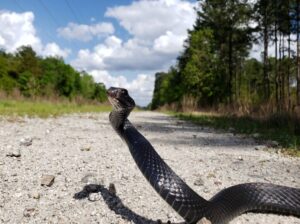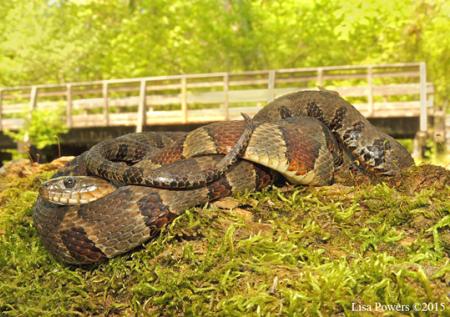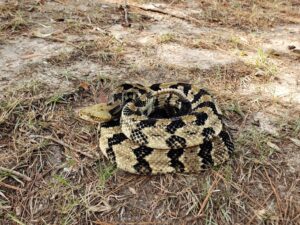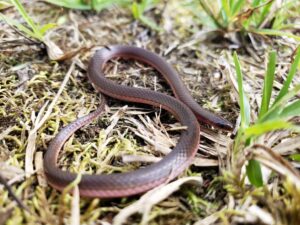
Heather N. Kolich, ANR Agent, UGA Extension Forsyth County
As spring advances, I’ve heard and seen the return of many migratory birds. Bats are active as insects emerge from overwintering in the soil, leaflitter, rotting logs, hollow plant stems, and other hidey-holes. Frogs and toads are calling.
The warmer temperatures also lure snakes from their tunnels, causing dismay for many people. Fear is a common reaction to encountering a snake, and a small percentage of humans (1-4%) have an extreme fear known as ophidiophobia. But most snakes are actually beneficial for gardeners, homeowners, and nature lovers.

Snakes don’t dig tunnels under homes and driveways, but they might live in the tunnels after they eat the chipmunks that dig them. Snakes don’t damage our garden plants, but they eat the slugs that do. Snakes also eat other pests, including termites and rats. In turn, snakes are food for small and large birds.
Georgia is a biologically diverse state, and that extends to snakes. We have 47 snake species native to Georgia, and they come in a variety of sizes. Small, ground-dwelling snakes, like the worm snake, southeastern crown snake, and ringneck snake, are only 7-15 inches long at maturity. Slender, tree-climbing rough green snakes can reach 38 inches in length. Insects are the primary food source for each of these snakes.

Large snakes in North Georgia include the black racer (up to 5 feet long), rat snake (up to 8 feet long), and northern watersnake (around 4 feet long). The first two are land snakes that live in a variety of habitats throughout the southeast. They provide rodent control. Racers move very fast along the ground, and rat snakes can climb straight up tree trunks. Northern watersnakes live around water and eat fish, frogs, and salamanders. They are often confused with the venomous cottonmouth, but cottonmouth snakes are generally restricted to coastal Georgia.
Fortunately, only seven snakes native to Georgia are venomous. Even better, of the 25 snake species with ranges that include Forsyth County, only three are venomous. Several North Georgia species spend most of their time underground or hiding in leaf litter and logs and are rarely encountered. In Georgia, all non-venomous snakes are protected species.

The three venomous snakes present in Forsyth County are copperheads (Agkistrodon contortrix), the canebrake rattlesnake, also known as the timber rattlesnake (Crotalus horridus), and the pigmy rattlesnake (Sistrurus miliarius). All three of these snakes are found throughout much of the state.
While only venomous snakes can inject a toxin, all snakes can strike and bite. It’s how they capture food. Non-venomous snakes seize the prey and hold on, either swallowing it live or, in the case of constrictors like rat snakes, coiling around the prey and squeezing so tightly the animal can’t draw breath. Vipers, however, strike their prey, deliver the toxin, then let go. They follow the trail of the “escaping” animal as the toxin kills it, then swallow it once it dies.

The best way to avoid getting bitten by a snake is to avoid them. Snakes hide well and strike fast. Snakes hunt and hang out in brush piles, rock piles, rotting logs, and under thick groundcover, such as English ivy. Stay away from these habitats, especially on warm days, and remove these habitats from your yard to reduce the chances of encountering snakes near home.
Snakes are most active from April through October. While most snakes are only active during the day, some hunt or move around on warm evenings. A study by Emory University indicates that the risk of getting bitten by a snake increases at higher temperatures.

When outdoors, wear thick, closed-toe shoes or, better yet, tall boots and long, loose pants to protect feet and legs from snake bites as well as other natural hazards. Make noise and use a long stick to sweep through tall grass and weeds before stepping into the area. This gives the snake the opportunity to flee. Don’t turn over rocks; many snakes hide under rocks and may strike if they are startled or cornered. Never pick up or handle snakes. Even if the snake isn’t venomous, its bite can hurt and cause infection.
If you or a family member suffers a snake bite, the Georgia Poison Center advises that you remain calm and seek medical attention immediately.
In the event of snake bite:
| Do | Do Not |
| Stay still and calm | Try to catch the snake |
| Remove jewelry and tight clothing | Apply a tourniquet |
| Note the time when the bite occured | Cut the wound |
| Wash the bite with soap and water | Attempt to suck the venom from the wound |
| Cover the bite with a clean, dry dressing | Apply heat or cold or any substance to the bite |
| Seek medical attention immediately | Drink alcohol or caffeinated beverages |
| Call the GPC at 1-800-222-1222 | Take any drugs or medicines |